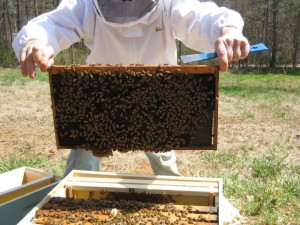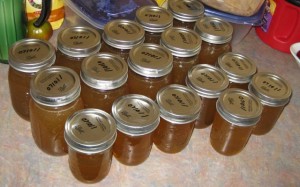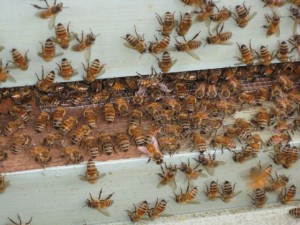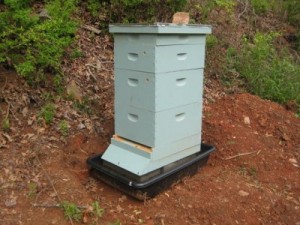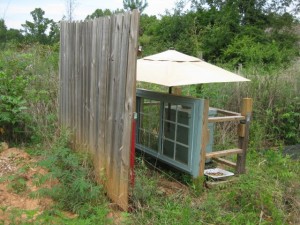Why I started with bees
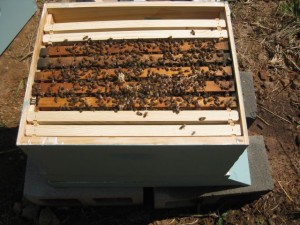
I began with bees in spring 2010. Maybe it was a description of bees trailing the sky by Cicero, which I read in my youth, or the wish for a more interactive relationship with nature than tracking down and despatching vegetable pests, or the need for a new challenge, or the thought (probably erroneous) that I needed to improve pollination. So I joined the Metro Atlanta Beekeepers’ Association, attended their one day course for beginners, purchased a nuke (5 frames loaded with bees and a queen) and acquired various pieces of equipment.
I enjoy reading up on topics and, in addition to the usual books, I especially enjoyed “Langstroth’s Hive and Honey-Bee” written in the mid 19th century. This is the classic beekeeper’s manual and includes along with insights and detailed observations, such gentle asides as (on how bees work to the very end of their life): “Place yourself before a hive, and see the indefatigable energy of these industrious veterans, toiling along with their heavy burdens, side by side with their more youthful compeers, and then judge if, while qualified for useful labor, you ought ever to surrender yourself to slothful indulgence.” (at page 59 of the 4th edition published in 1878).
The overprotective bee keeper
I molycoddled my bees, and made a number of elementary mistakes in the process. In the early spring months, before the flowers bloomed I provided them with sugared water, which was ok. However, I noticed large ants accessing the syrup feeder from the outside of the hive – so I placed the hive in a moat – see adjoining photo. My mistake was I left the moat in place after supplementary feeding was no longer required and ants were no longer a problem, and a # of bees ended up in the water and drowned. Once I realized the extent of the problem I quickly discontinued with the moat.
I also provided a watering station – stones in a mixing trough fed continuously from a 40 gal fresh water tank. The mistake was to locate it too close to the hive – apparently the bee dance does not locate spots within 15 ft of the hive.
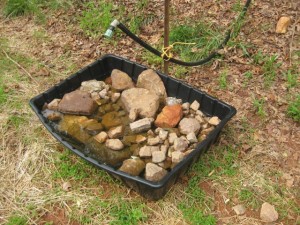
I was concerned about overheating and ventilation. So I constructed a sunshade to protect the hive from the summer morning sun, and various screened ventilation holes to enable more air circulation. I figured the bees could regulate air movement by plugging the holes with propolis, if necessary.
In their first year my bees seemed to be continuously swarming and each time they swarmed about half the hive and half the honey went out the hive. I wasn’t sure whether they had a problem with the living arrangements or if they were naturally pre-disposed to swarming. Maybe it was a tribute to me, since swarming is how the colony reproduces itself and their continuous swarming may have testified to their vigor and good health? If I had diligently examined the hive every couple weeks and ensured that I still had a queen, and then squashed the queen cells to prevent new queens emerging, that might have ended the swarming. But I didn’t.
New bee living quarters
At the end of the season there was not much honey and I decided to leave the bees their honey and hope they would make it through the winter. The winter mortality rate for bees can be as high as 30%. I also resolved not to feed them any chemicals. Finally, as winter approached I decided their location on the east side of the hill would handicap their survival chances. So I physically relocated the hive to an open, fully sun exposed spot and then constructed a frame around the hive. On the west (pm sun facing side I located an insulated window (bought as a reject from the manufacturers) and had plastic sheeting around the other sides and reduced the entrance size. Also closed off the opening below the hive body. Their honey reserves kept them going through March when I resumed supplementary feeding. And they survived. Rather than relocate the hive again in the summer (each relocation results in bee losses), I erected a fence to the west side of the hive to block the afternoon sun and purchased a sun umbrella.

As of July 2011 they seem fine – I harvested/robbed them of 3 frames = 1.4 gallons of honey at the end of June and another 3 frames = 1.4 gallons of honey in mid-July and then again in early August. The honey is delicious but each harvesting has produced differently tasting honey since the flowers they visit continuously change as the season advances.
